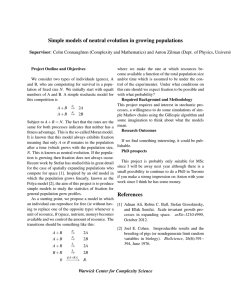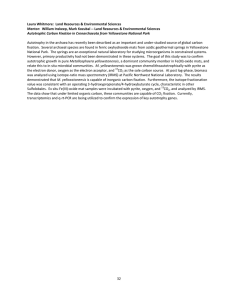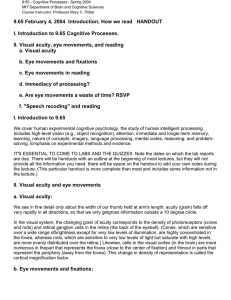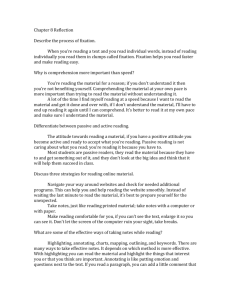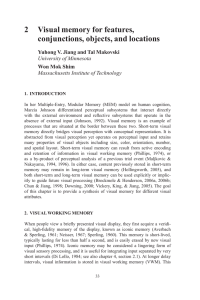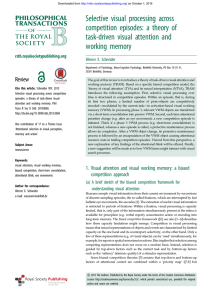Title
advertisement
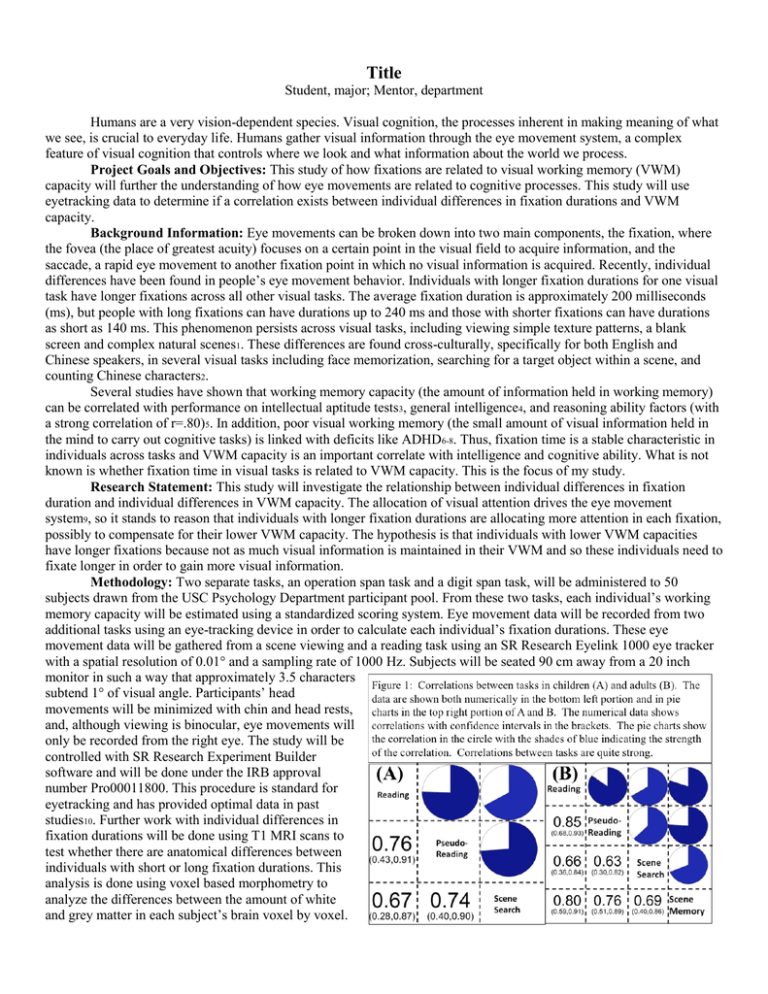
Title
Student, major; Mentor, department
Humans are a very vision-dependent species. Visual cognition, the processes inherent in making meaning of what
we see, is crucial to everyday life. Humans gather visual information through the eye movement system, a complex
feature of visual cognition that controls where we look and what information about the world we process.
Project Goals and Objectives: This study of how fixations are related to visual working memory (VWM)
capacity will further the understanding of how eye movements are related to cognitive processes. This study will use
eyetracking data to determine if a correlation exists between individual differences in fixation durations and VWM
capacity.
Background Information: Eye movements can be broken down into two main components, the fixation, where
the fovea (the place of greatest acuity) focuses on a certain point in the visual field to acquire information, and the
saccade, a rapid eye movement to another fixation point in which no visual information is acquired. Recently, individual
differences have been found in people’s eye movement behavior. Individuals with longer fixation durations for one visual
task have longer fixations across all other visual tasks. The average fixation duration is approximately 200 milliseconds
(ms), but people with long fixations can have durations up to 240 ms and those with shorter fixations can have durations
as short as 140 ms. This phenomenon persists across visual tasks, including viewing simple texture patterns, a blank
screen and complex natural scenes1. These differences are found cross-culturally, specifically for both English and
Chinese speakers, in several visual tasks including face memorization, searching for a target object within a scene, and
counting Chinese characters2.
Several studies have shown that working memory capacity (the amount of information held in working memory)
can be correlated with performance on intellectual aptitude tests3, general intelligence4, and reasoning ability factors (with
a strong correlation of r=.80)5. In addition, poor visual working memory (the small amount of visual information held in
the mind to carry out cognitive tasks) is linked with deficits like ADHD6-8. Thus, fixation time is a stable characteristic in
individuals across tasks and VWM capacity is an important correlate with intelligence and cognitive ability. What is not
known is whether fixation time in visual tasks is related to VWM capacity. This is the focus of my study.
Research Statement: This study will investigate the relationship between individual differences in fixation
duration and individual differences in VWM capacity. The allocation of visual attention drives the eye movement
system9, so it stands to reason that individuals with longer fixation durations are allocating more attention in each fixation,
possibly to compensate for their lower VWM capacity. The hypothesis is that individuals with lower VWM capacities
have longer fixations because not as much visual information is maintained in their VWM and so these individuals need to
fixate longer in order to gain more visual information.
Methodology: Two separate tasks, an operation span task and a digit span task, will be administered to 50
subjects drawn from the USC Psychology Department participant pool. From these two tasks, each individual’s working
memory capacity will be estimated using a standardized scoring system. Eye movement data will be recorded from two
additional tasks using an eye-tracking device in order to calculate each individual’s fixation durations. These eye
movement data will be gathered from a scene viewing and a reading task using an SR Research Eyelink 1000 eye tracker
with a spatial resolution of 0.01° and a sampling rate of 1000 Hz. Subjects will be seated 90 cm away from a 20 inch
monitor in such a way that approximately 3.5 characters
subtend 1° of visual angle. Participants’ head
movements will be minimized with chin and head rests,
and, although viewing is binocular, eye movements will
only be recorded from the right eye. The study will be
controlled with SR Research Experiment Builder
software and will be done under the IRB approval
number Pro00011800. This procedure is standard for
eyetracking and has provided optimal data in past
studies10. Further work with individual differences in
fixation durations will be done using T1 MRI scans to
test whether there are anatomical differences between
individuals with short or long fixation durations. This
analysis is done using voxel based morphometry to
analyze the differences between the amount of white
and grey matter in each subject’s brain voxel by voxel.
Past Research: I collected data
using an eye-tracking device to test
whether individual differences in
fixation duration can be accounted for by
differences in the state of the subject. It
is possible that these differences could
be caused by the internal state of the
subject at the time the data were
collected. A person with long fixations
one day could have shorter fixations
another day simply because he or she
slept better one day or because he or she
was less distracted. Participants were
given the same five viewing tasks in the
eyetracker and their eye movements
were recorded on two separate days. The
results show a very strong correlation between sessions for each of the four tasks. Of the 4 tasks, the lowest correlation
between the first and second session for the same tasks was .85 with a confidence interval of (0.86,0.93). Figure 1 shows
the correlation between the tasks for both sessions. A follow up study done on children ages 11-13 performing three of the
same tasks administered to the original subjects produced similar results, though not as highly correlated.
In addition, I investigated how well people understand the limits of their own working memories by comparing
experimentally determined VWM capacity values with self-reported storage judgments in which the participants report
how many items they believe they have in their working memories. The results indicated that those participants with
experimentally determined better working memories were more accurate with the storage judgments than those with poor
working memories. Both groups overestimated the amount of items they had in working memory, but those with better
working memories were closer to their actual capacity (Figure 2).
Project Significance: If a correlation can be established between eye movement data and working memory
capacity, this correlation could lead to a new objective diagnostic tool for learning disorders or a method for customizing
instruction to fit educational needs. This new tool could also reduce the problem of over-diagnosis of ADHD11.
Additionally, recent evidence shows that working memory deficits can be linked to depression12. If working memory
capacity can be correlated with eye movement data, this may help to identify individuals at risk of depression or who may
be currently suffering from depression. Finding a link between quantifiable eye movements and working memory
capacities will provide much needed insight into the differences in cognitive processing among individuals.
Project Timeline:
TASK
Project Month (Fall 2013-Spring 2014)
July
Sept
Oct
Nov
Dec
Jan
Feb
Literature Review
X
X
X
X
X
X
Experimental Design
X
X
Collection of Data
X
X
X
Analysis
X
X
X
Write-up
X
Final Products and Dissemination: This project will be presented at Discovery Day 2014. In addition, the paper
will be submitted to IMPULSE, the online neuroscience undergraduate research journal, as well as presented at
SYNAPSE (Symposium for Young Neuroscientists And Professors of the SouthEast).
Personal statement: When I first looked at MRI images of the scanned brain, with all of its various components
and functions, it seemed to me like magic that this hunk of matter could generate all human behavior, from the most
menial task of breathing to the ability to contemplate the meaning of life. The image of this chunk of matter that, as the
famous neuroscientist Jill Taylor says, “connects [our] dreams to a common reality,” left me completely awestruck. Now,
even four years after that day in the MRI lab, I still feel that same wonderment about the brain as when I saw that first
scan. I will pursue a career in cognitive neuroscience research in academia by obtaining a Ph.D. in cognitive neuroscience
and then continue on with research in a post-doctoral position. My goal is to research cognitive processes at a university
level using innovative brain imaging technology. This project allows me to pursue my passion of cognitive neuroscience
research, and in doing so prepares me for a career in this field.
References:
1
Andrews, T., & Coppola, D. (1999). Idiosyncratic characteristics of saccadic eye movements when viewing different
visual environments. Vision Research, 39, 2947-2953.
2
Rayner, K., Li, X., Williams, C., Cave, K., & Well, A. (2007). Eye movements during information processing tasks:
Individual differences and cultural effects. Vision Research, 47, 2714-2726.
3
Daneman, M., & Carpenter, P. (1980). Individual differences in working memory and reading. Journal of Verbal
Learning and Verbal Behavior, 19(4), 450-466.
4
Oberauer, K., Wilhelm, O., Schulze, R., & Sub, H. (2005). Working Memory and Intelligence-Their Correlation and
Their Relation: Comment on Ackerman, Beier, and Boyle. Psychological Bulletin, 131(1), 61-65.
5
Kyllonen, P., & Christal, R. (1990). Reasoning ability is (little more than) working- memory capacity?!. Intelligence,
14(4), 389-433.
6
Castellanos, F. X., & Tannock, R. (2002). Neuroscience of attention deficit/hyperactivity disorder: The search for
endophenotypes. Nature Review Neuroscience, 3, 617–628.
7
Rapport, M. D., Alderson, R. M., Kofler, M. J., Sarver, D. E., Bolden, J., & Sims, V. (2008). Working memory deficits
in boys with Attention-deficit/Hyperactivity Disorder (ADHD): The contribution of central executive and
subsystem processes. Journal of Abnormal Child Psychology, 36, 825–837.
8
Klingberg, T., Fernell, E., Olesen, P. J., Johnson, M., Gustafsson, M.D., Dahlstrom, M. D. (2005). Computerized
training of working memory in children with ADHD—A randomized, controlled trial. Journal of the American
Academy of Child and Adolescent Psychiatry, 44, 177–186.
9
Henderson, J. (2003). Human gaze control during real-world scene perception. Trends in Cognitive Sciences, 7(11),
498-504.
10
Henderson, J. M., & Luke, S. G. (2012). Oculomotor inhibition of return in normal and mindless reading. Psychonomic
Bulletin & Review, 19, 1101-1107
11
Levens, S., & Gotlib, I. (2010). Updating positive and negative stimuli in working memory in depression. Journal of
Experimental Psychology: General, 139(4), 654-664.
12
Arnett, P. A., Higginson, C. H., Voss, W. D., Bender, W. I., Wurst, J. M., & Tippin, J. M. (1999). Depression in
multiple sclerosis: Relationship to working memory capacity. Neuropsychology, 13, 546- 556.
!"#$%&'(#)*(%"&'$"&$*"+,-.(%&/$(0%'$1"#+2$0((,2334445'*5.6)3")#36"*3789:;<=&'(#)*(%"&'1"#>?@95,61$$
!"#$%%"&'()*+%",'-./012'345!'
$
A()6.&(B'$CD+.2$ED*F.&G%.$A)&6DH$
$
'
Double-click on table to enter data
-67#$8'96:8;<;)"8;+&'
'
(867$&8'("%",=>$=&6%*D(.$.'(%+D(.6$&)+I.#$"1$'()6.&($#.'.D#*0$0")#'$,.#$4..F$D&6$0")#-H$#D(.$'.,D#D(.6$IH$'.+.'(.#'$40.&$
'()6.&($%'$.&#"--.6$%&$*-D''.'$"#$&"($.&#"--.6$%&$*-D''.'$J/.&.#D--H$1D--$"#$',#%&/$K'$')++.#$'.+.'(.#'L5'
'
?K.#$(0.$')++.#2$MN$0#'34..F$1"#$O$4..F'$D($PMN5NN$,.#$0#$
>0%-.$%&$*-D''2$Q$0#'34..F$1"#$RMO$4..F'$D($PMN5NN$,.#$0#$
'
!"8$,;"%:?(6@@%;$:>$=&6%*D(.$%(.+'S$T)D&(%(HS$D&6$.'(%+D(.6$,#%*.5$!"#$%&"#'(#)*+,%-"#'./"$#(*#.,,#0%&+1.$"$2$
$
U#%&(%&/$*"'($1"#$9%'*"K.#H$9DH$,"'(.#2$PVW5NN$
U#%&(%&/$*"'($1"#$AXCYUA;$,"'(.#2$PVW5NN$
$
<"(D-2$PMWN5NN$
$
2,"A$%>$=&6%*D(.$-"*D(%"&S$,)#,"'.$"1$(#DK.-S$.'(%+D(.$%(.+%G.6$*"'('$J(#D&',"#(D(%"&S$-"6/%&/S$#./%'(#D(%"&S$.(*L5$
$
C"$(#DK.-$*"'('$D#.$D&(%*%,D(.6$1"#$(0%'$,#"Z.*(5$
$
$
$

